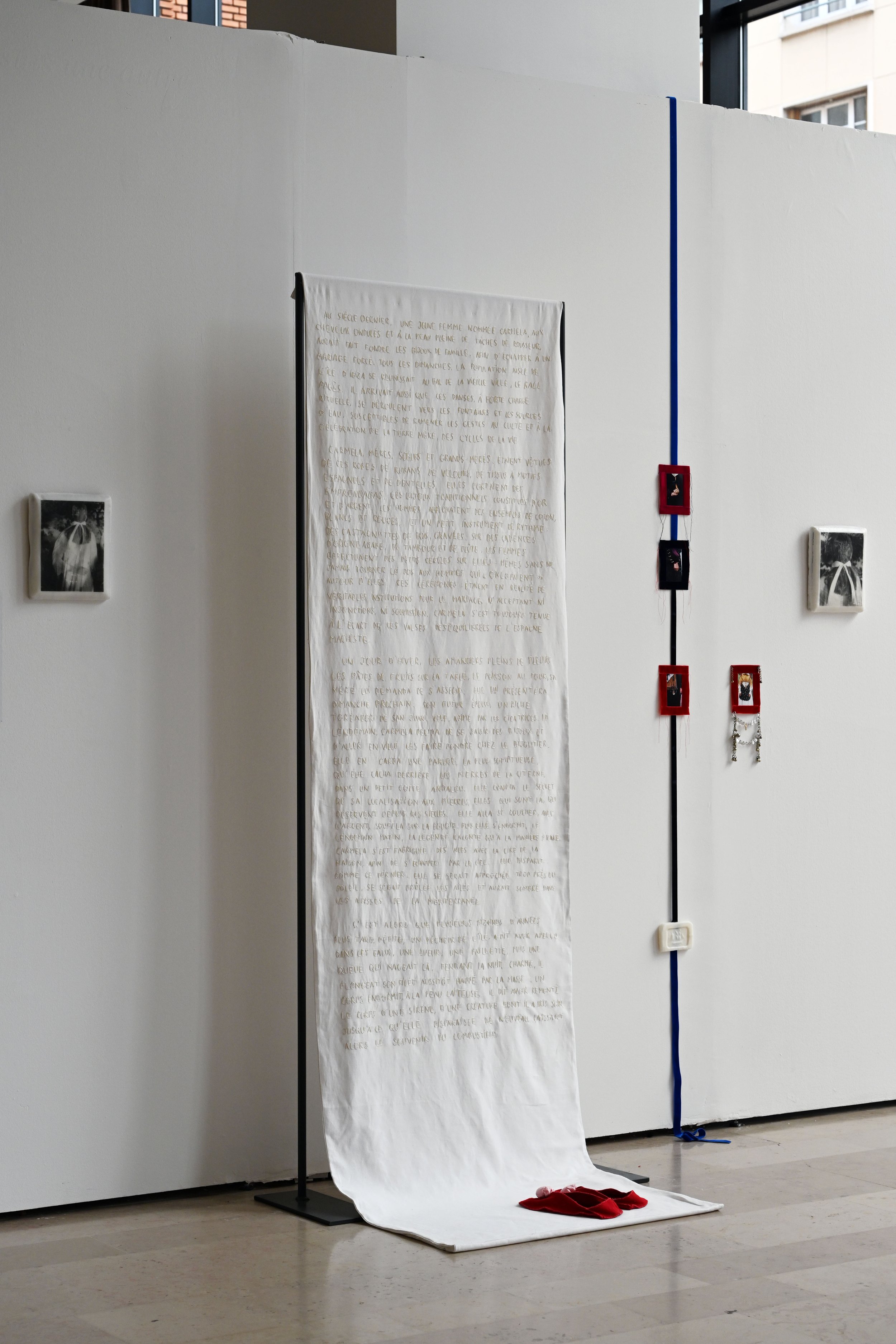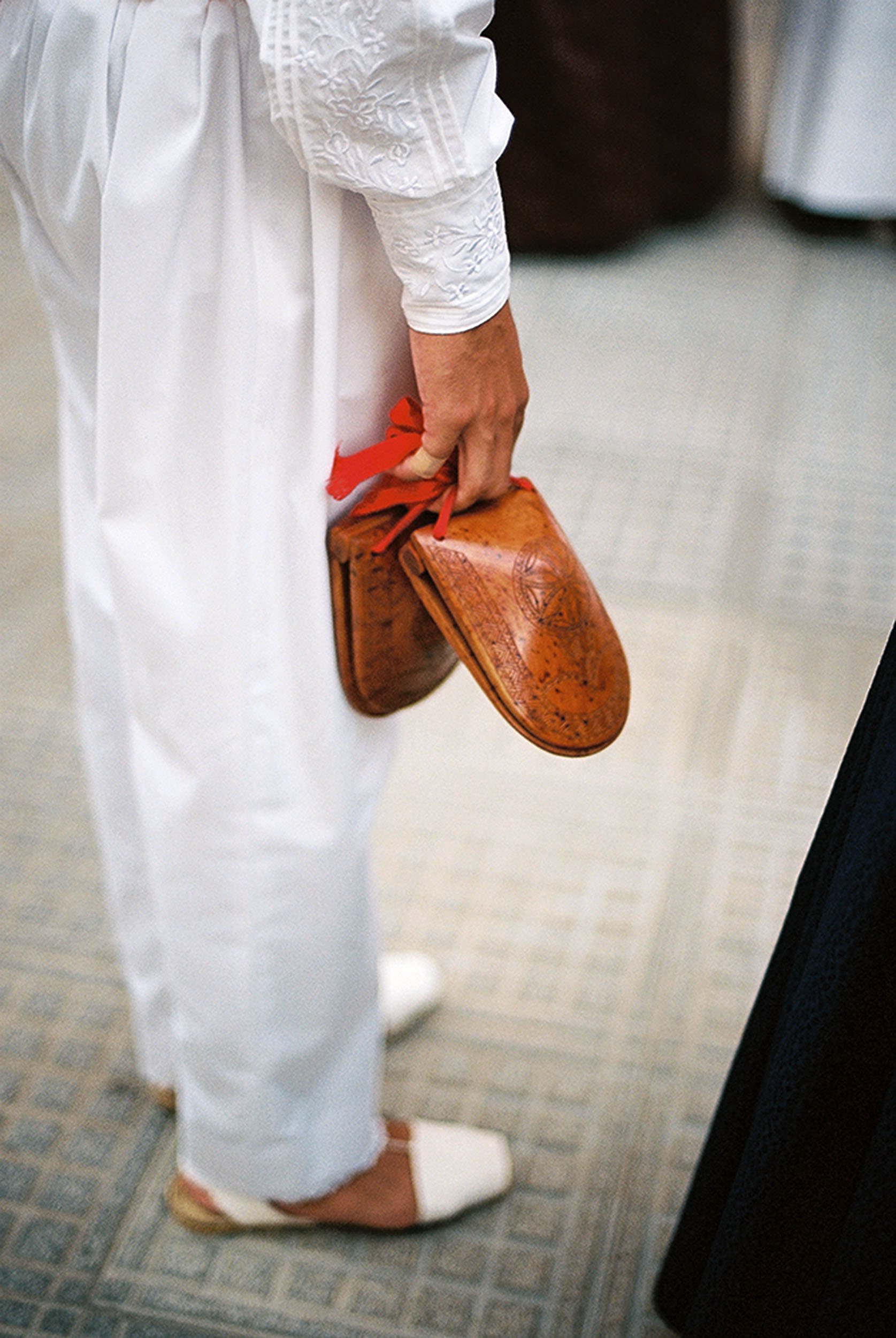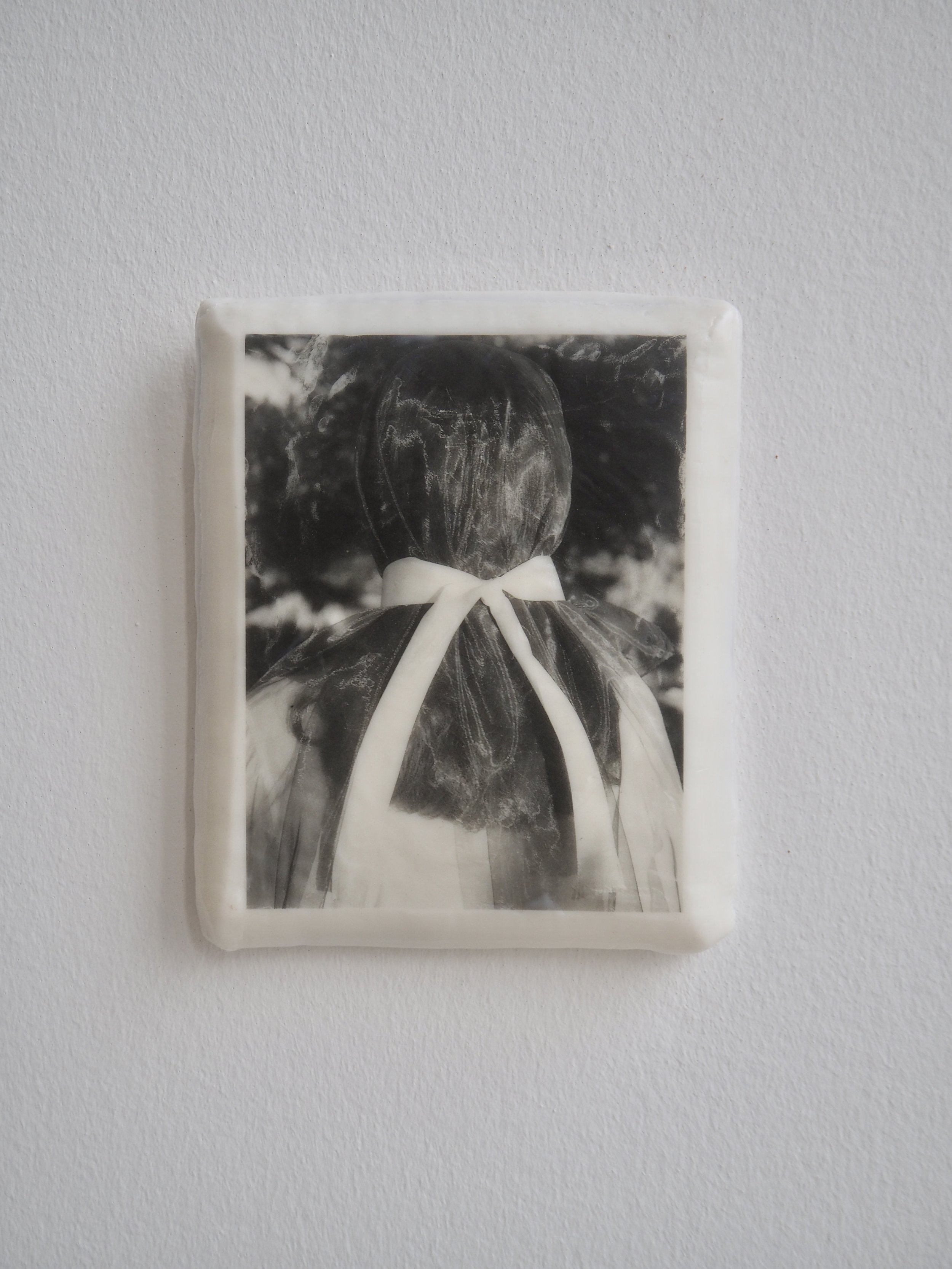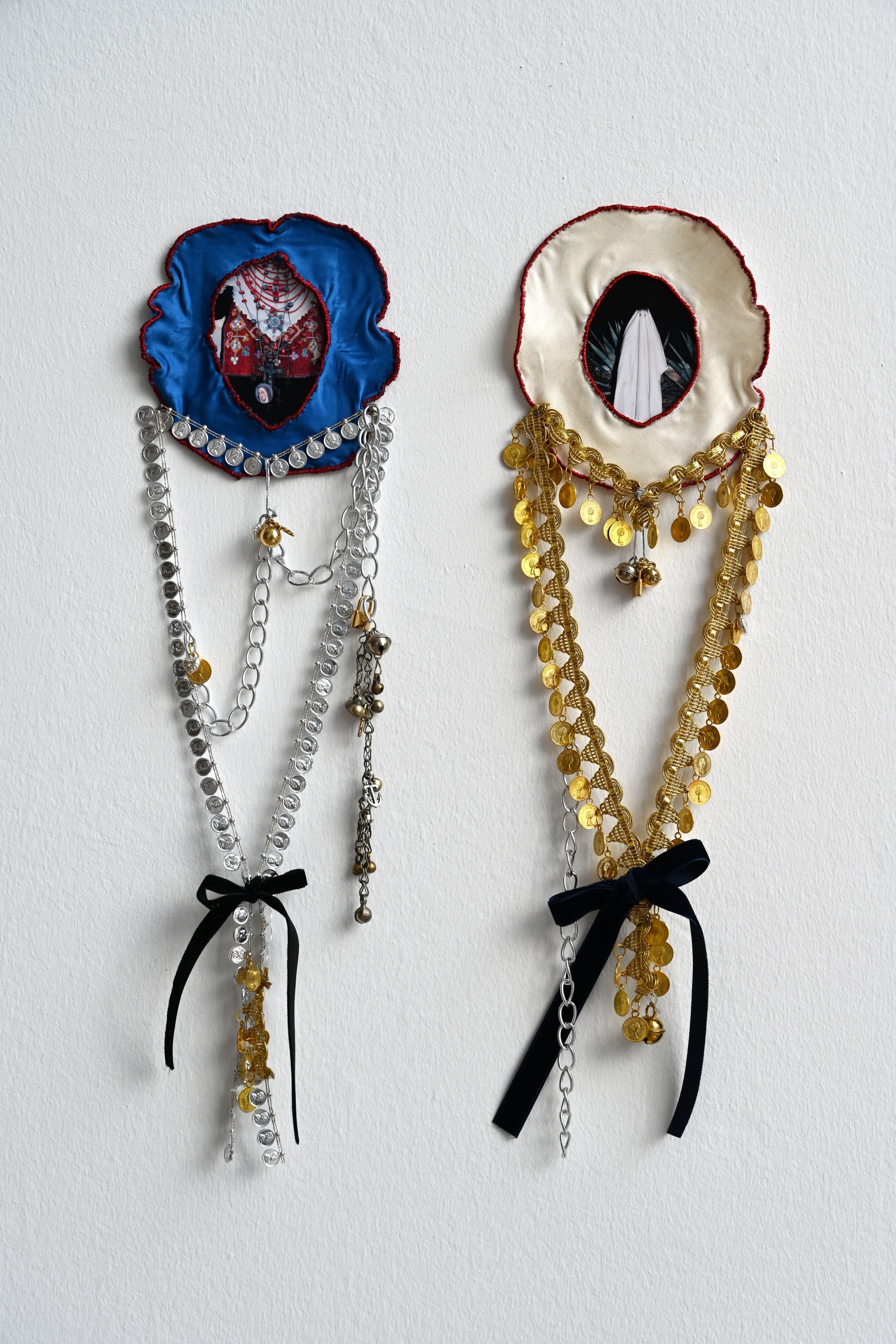Clara Eugène in Conversation with Artist Emma Tholot
Emma Tholot is a French visual artist born in 1994. Her work is mainly autobiographical and refers in particular to her Mediterranean origins. It explores the intergenerational transmission of myths and beliefs and is deeply focused on representing cultural rituals and traditions that bind us together. Her transdisciplinary practice oscillates between photography, video, installation, sewing, sculpture, but also food art.
A graduate of École des Arts Décoratifs (ENSAD) Paris since 2020, Emma lives and works between Paris and Marseille. She was selected to exhibit her work at the 67th Edition of the Salon de Montrouge (October 6 - October 29, 2023) alongside 35 other emerging artists.
Emma Tholot, Installation at Salon de Montrouge (2023). Photo Courtesy: Emma Tholot.
Clara Eugène: Let’s begin with your journey into the Art World. Could you tell us a little more about your artistic background, when and how did you start creating?
Emma Tholot: As a teenager, I used to create a lot of collages using magazines I would find at home. In that sense, I began my research through the assemblage and association of patterns, themes and narratives. But going to an art school was not an option; I wasn’t even aware of them. It came later, after a year of Sciences Po preparatory classes, when I was 19.
CE: Through your artistic practice, you explore your cultural heritage, particularly the Mediterranean one transmitted by your Spanish grandmother. Your installation Carmela at the 67e Salon de Montrouge reveals a universe filled with rituals and beliefs. You invite us into your intimacy by creating visual narratives inspired by tales that lulled you - such as the myth of Carmela. Can you tell us a little bit more about your relation to the Mediterranean and how your origins influence your artistic practice?
ET: I consider the Mediterranean area as an unbounded space made up of a multitude of crossroads between the countries that populate it. These intersections manifest in gastronomy, jewelry, religious buildings, dances, superstitions, and so on. When I take an interest in a ritualized practice in Spain, such as the Ball Pagès in Ibiza, I seek to identify the symbols, adornments and postures that one might find in the Tarantella of Naples or the Zendali of eastern Algeria, for example. I search for the stories, founding myths and heritages - tangible and intangible - that we might have in common, to identify what connects us from one shore to the other.
On a more intimate level, there is something about the spontaneity, even impulsiveness, that seems to me characteristic of the Mediterranean instinct - when I create a piece, after hours of research and work on an embroidery, for example, I take the risk of making mistakes in the measurements, setting the iron too hot or cutting too quickly. I like this contradiction.
CE: There is a strong feminist dimension in the myth of Carmela. Somewhat as Icarus, she creates wax wings to escape a forced marriage. In your installation, you notably use the mediums of wax and embroidery to share her story of emancipation.
“These ceremonies were in fact veritable institutions for marriage. Accepting neither injections nor submission, Carmela has always stayed away from these unbalanced waltzes of macho Spain.”
Do you think of your work in political terms? Is celebrating feminine independence and strength an important aspect of your practice?
ET: Yes, I would find my research completely detached if it were confined to my fascination with rituals and adornments. I am aware that each ritualized practice, especially when made public, carries ambivalences, gender imbalances as well as ethical and inclusiveness issues. Since rituals are inherently traditional and often archaic, it seems important to me to approach them through both an ethnographic and a socio-political perspectives, and to attempt, through my work, to redefine certain contours, fairer and more adapted to contemporary concerns.
In addition to see women’s independence and gender parity grow, there is also the desire to observe greater social justice in customs and, by extension, in societies.
CE: Your works include a wide variety of mediums such as satin, lace, wax, jewels... How did you come to include them, almost as main subjects, in your works?
ET: All the materials I integrate into my work are charged with meaning. It is my connection to fabric that has strongly influenced my practice; it is a material imbued with spirit. The Greeks extended their influence on the body, the city, love, language and even the construction of the cosmos. It links, transmits, connects: the past and present, the individual to his group, matter to the living, the feminine to the masculine, and the infant to the corpse, from swaddling clothes to shroud. My hometown, Saint-Etienne, is also renowned for its textiles and ribbons.
I then incorporated metal into my forms, as if to harden them and find a formal vocabulary for the dualities and ambivalences described earlier; bells, locks and chains, recovered from antique jewelry or bazaars, represent both celebration and restraint.
Finally, wax appears to me as a metaphorical material for skin, perspiration, transformation and, by extension, death. From domestic to votive candles and medieval ex-votos, wax represents the interplay between presence and absence, the visible and the invisible.
CE: Your installation Carmela features mysterious photographs of ghosts, a kid disguised as a magician, the hair of a woman covered by a veil, an empty chair… What does this magical, almost sacred, dimension represents for you?
ET: My grandmother, who had clairvoyant gifts, used to tell me about her visions of little monsters and creatures from Spanish mythology, family legends, people who returned, the language of wells and stones... It is my way of unveiling the invisible and expressing strangeness, offering a glimpse into the realm of imagination and magic.
Sometimes, I dream of scenes, and I try to create a photograph based on the image that remains when I wake up. Imaging the enchanted and the supernatural is also an attempt to create parallel narratives to help us live with the harshness and horror of some current images in the news.
CE: Your interest in disguises, masks, and costumes - mainly related to traditional rituals - is also reflected in your series Addio Pulcinella. Can you tell us a little more about this project?
ET: I lived in Rome in 2018 and created my first photographic series, titled La Bombola, which focused on Italian theater and its representations in the public space. Then, last November, I did a residence in Palermo, supported by the French Institute of Italy. I had the chance to conduct more specific research on one of the characters from the Commedia dell’arte: Pulcinella. He is a mystery, an intuition, a metaphor. He embodies a paradoxical form of ideal, and his ambivalence and duality make him half-living, half-dead, half-visible, half-invisible, half-man, half-woman. He embodies the myth of the hermaphrodite, the perfect being, a synthesis of the masculine and the feminine, and thus of the universe. I wanted to reinterpret his costume by adding symbols daily and writing the diary of his journey, a transfer of my own Palermo wanderings. More broadly, I am interested in archetypal figures: Pulcinella, but also the witch, the magician, the shepherd, the divine child, for example. They form a troupe, a banquet, allowing to create a body of installations, images, and narratives.
Emma Tholot, Addio Pulcinella (2022). Photo Courtesy: Emma Tholot.
CE: What has been your relationship with archives and how has it influenced your work?
ET: I consult the archives of conservation centers, libraries and dedicated platforms, which I classify into folders by themes and images, but I also attempt to create my own documentation. It consists of analog photographs, collage notebooks, notes and recipes, brought-back objects, songs transmitted through oral tradition, magazine clippings and more. Since I am not an ethnographer, I don't consider myself an archivist, but rather a researcher, which goes hand in hand with my artistic proposals and, above all, feeds them.
CE: What are your main sources of inspiration today?
ET: Rituals, old restaurants, Neorealism, Baroque and Surrealism, tales and popular culture, Rosalía, traditional costumes, the Mediterranean, Francisco de Goya, Niki de Saint Phalle, Gégard Garouste, Chantal Akerman, Federico Fellini.
Clara Eugène
Contributing Writer, MADE IN BED







